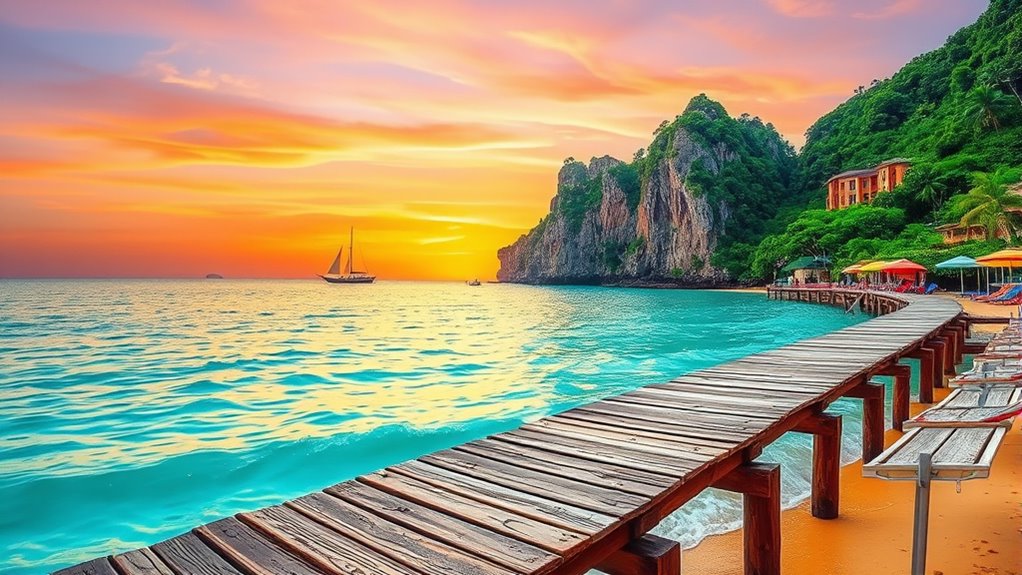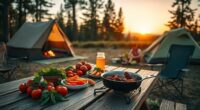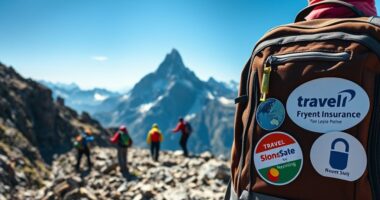To take great travel photos, focus on natural lighting like early mornings or late afternoons for warm, soft tones. Use your gear wisely—wide-angle for landscapes and a tripod for stability. Experiment with camera settings such as aperture and exposure to adapt to different scenes. Composition is key—apply the rule of thirds, include leading lines, and capture candid moments. Keep practicing various angles and techniques, and you’ll discover how to turn your travel moments into memorable images.
Key Takeaways
- Use natural lighting during early mornings and late afternoons for warm, soft, and visually appealing photos.
- Incorporate composition techniques like the rule of thirds and leading lines to create balanced images.
- Keep your camera ready and experiment with different angles, settings, and gear to capture diverse shots.
- Include foreground elements and natural frames to add depth and perspective to your photos.
- Minimize background clutter and focus on candid moments to tell authentic, engaging travel stories.

Ever wondered how to capture the true essence of your vacation? The secret lies in mastering your lighting techniques and understanding your camera gear. Good lighting transforms ordinary scenes into extraordinary photographs, so pay attention to the natural light around you. Early mornings and late afternoons offer soft, warm light that adds depth and mood to your shots. During midday, when the sun is harsh, seek shaded areas or use your camera’s exposure compensation to prevent overexposed highlights. If you’re carrying a DSLR or mirrorless camera, experiment with different settings to control how much light enters the lens. Using a polarizing filter can also help reduce glare on water or glass, making your photos clearer and more vibrant.
Your camera gear plays a essential role in capturing high-quality images. While smartphones are more than capable, investing in a versatile camera can elevate your travel photography. Consider bringing a wide-angle lens for landscapes and architecture, and a zoom lens for capturing distant subjects or wildlife. A sturdy tripod is invaluable for low-light conditions, long exposures, or capturing sharp images without camera shake. Keep extra batteries and memory cards handy, especially if you’re exploring remote areas where charging options are limited. Familiarize yourself with your camera’s settings before your trip; knowing how to quickly switch between modes like aperture priority or manual can save you precious time when you spot the perfect shot.
Composition is just as important as gear and lighting. Use the rule of thirds to create balanced images, placing key subjects off-center to add interest. Look for leading lines or natural frames—like archways or overhanging branches—to draw the viewer’s eye into your scene. Pay attention to details such as foreground elements, which add depth, and background clutter that might distract from your main subject. If you’re shooting people, try to capture candid moments that showcase their genuine expressions rather than posed shots. These authentic images often tell the most compelling stories of your trip.
Ultimately, great vacation photos come down to preparation and awareness. Keep your camera ready, experiment with different lighting techniques, and leverage your gear’s capabilities. Don’t be afraid to take multiple shots from different angles or settings—sometimes the best image emerges from a bit of trial and error. With a little practice and attention to detail, you’ll create memorable photos that truly reflect the spirit of your travels.
Frequently Asked Questions
How Can I Protect My Camera From Weather Damage?
You can safeguard your camera from weather damage by investing in camera waterproofing solutions, like weatherproof camera cases, that shield against rain, snow, and dust. Always check if your camera is weatherproof or if you need additional protection. When outdoors, use a rain cover or a weatherproof bag and avoid exposing your camera to the elements for extended periods. These precautions help ensure your gear stays safe and functional.
What Are the Best Settings for Low-Light Travel Photos?
When shooting low-light travel photos, you should adjust your camera settings to maximize light sensitivity. Increase your ISO to capture more light, but be cautious of noise. Use a wider aperture to let in more light and set a slower shutter speed for better exposure. Tripods help stabilize shots with slow shutter speeds, ensuring sharp images. Experiment with these settings to find the perfect balance for vibrant, clear photos in dim conditions.
How Do I Photograph Wildlife Without Disturbing Them?
Think of wildlife photography as a delicate dance—you want to capture the moment without stepping on any toes. To do this, practice stealth shooting, using a long lens and minimizing noise. Respect wildlife ethics by keeping your distance and avoiding sudden movements. By moving slowly and blending into the environment, you let animals go about their day naturally, giving you authentic shots while preserving their peace and safety.
Which Accessories Are Essential for Travel Photography?
When you’re choosing accessories for travel photography, focus on tripod essentials to stabilize your shots and capture sharp images, especially in low light. A compact, lightweight tripod makes travel easier. Don’t forget lens cleaning kits to keep your lenses spotless, ensuring clear, professional-quality photos. These accessories help you maximize your camera’s potential, making your travel photos more stunning and memorable while keeping your gear in top condition.
How Can I Effectively Organize My Travel Photos Afterward?
Ever wonder how to keep your travel memories alive? You should start with effective photo sorting—organize images by location or date to easily find your favorites. Then, create digital backups on cloud storage or external drives to prevent loss. Do you want your adventures to stay vivid forever? Regularly update your backups and maintain organized albums, making it simple to relive your trip anytime and share your stories effortlessly.
Conclusion
Remember, the magic of vacation photography isn’t just about fancy gear or perfect settings—it’s about capturing moments that tell your story. Some say that the camera itself doesn’t matter; it’s your eye that makes the shot. So, trust your instincts, stay curious, and keep practicing. When you embrace this mindset, you’ll find that stunning travel photos come naturally. After all, the best shots often happen when you’re genuinely engaged and looking through your own unique lens.









